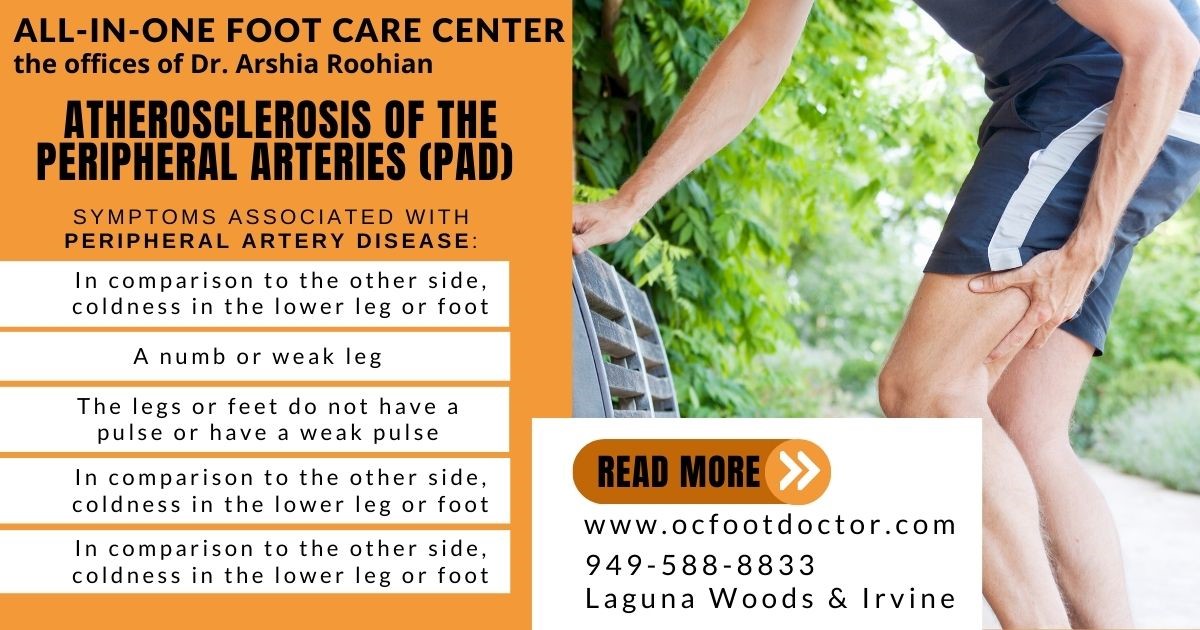Atherosclerosis Of The Peripheral Arteries (Pad)

An arm or leg's blood flow is restricted by narrowed arteries in peripheral artery disease (also called peripheral arterial disease).
It causes leg pain (claudication) and may also cause other symptoms, such as fatigue. Peripheral artery disease (PAD) is a chronic disease that contributes to low blood flow to the legs and arms.
Often associated with atherosclerosis (narrowing of the arteries), peripheral arterial disease occurs when fat deposits accumulate in the arteries (peripheral artery disease).
Exercise, a healthy diet, and avoiding tobacco use are all part of the treatment for peripheral artery disease.
Indications
There are many people with peripheral artery disease with mild, or no symptoms. Some people may experience pain in their legs when they walk (claudication).
Exercise-induced cramping or muscle pain in the legs or arms may be a sign of claudication symptoms. Leg pain can range in severity from mild to severe. It is most commonly felt in the calf. If the leg pain is severe, it may make it difficult to walk.
There may also be the following symptoms associated with peripheral artery disease:
- In comparison to the other side, coldness in the lower leg or foot
- A numb or weak leg
- The legs or feet do not have a pulse or have a weak pulse
- After walking or climbing stairs, you may experience cramping in your hips, thighs or calves
- Legs with a shiny finish
- Legs change color as they age
- Increasingly slow toenail growth
- An unhealed cut on the foot, leg, or toes
- When knitting, writing, or doing other manual labor, the arms ache and cramp
- Having trouble erecting
- Legs with less hair growth or hair loss
A person diagnosed with peripheral artery disease may experience pain during rest or when lying down. Pain that interrupts sleeping may be temporarily relieved by hanging the legs over the edge of the bed or walking.
Reasons
Atherosclerosis, the accumulation of fats and cholesterol on artery walls, is a common cause of peripheral artery disease.
As a result of atherosclerosis, the blood supply to the limbs is impeded. Peripheral artery disease results from atherosclerosis affecting the arteries throughout the body.
The peripheral arterial disease can also be caused by:
- Inflammation of the blood vessels
- A leg or arm injury
- Muscle or ligament changes
- Exposure to radioactive materials
An overview of the risks
Diabetes and smoking are two of the factors that increase peripheral artery disease risk. Other risk factors include:
- An underlying condition such as peripheral artery disease, heart disease or stroke in your family
- Hypertension
- Hypercholesterolemia
- The risk of coronary artery disease is increased by high levels of a substance called homocysteine
- Atherosclerosis is more likely to develop after 65 (or after 50 if you have risk factors for the disease)
- Overweight (BMI over 30)
Problems
Atherosclerosis-induced peripheral artery disease is associated with the following complications:
- The limbs are critically ischemic. The condition results in tissue death caused by an injury or infection. Symptoms include non-healing open wounds on the legs. Amputations may be recommended.
- Coronary artery disease and stroke. Heart and brain blood vessels can also be affected by plaque buildup in the arteries.
Preventative measures
It is essential to maintain a healthy lifestyle if you want to avoid leg pain caused by peripheral artery disease.
- Avoid smoking.
- Blood sugar control is essential.
- Reduce your intake of saturated fats by eating low-fat foods.
- Exercise regularly - but discuss with your health care provider what type and how much is best for you.
- Keep your weight in check.
- Maintain a healthy heart and blood pressure.
You can contact our office at 949-588-8833, or visit our website at https://www.ocfootdoctor.com. Our offices are in Laguna Hills, Irvine, Mission Viejo, Aliso Viejo, Lake Forest, Foothill Ranch, and Costa Mesa.
📲 949-588-8833
🏢 24331 El Toro Rd, Suite 370 Laguna Woods CA 92637
🏢Irvine Medical Arts Building 113 Waterworks Way, Suite 250 Irvine, CA 92618
🌐 https://www.ocfootdoctor.com/
The information contained above is intended for general reference purposes only. It is not a substitute for professional medical advice or a medical exam. Always seek the advice of your physician or other qualified health professionals before starting any new treatment. Health information on this website MUST NOT be used to diagnose, treat, cure or prevent any disease without the supervision of your doctor.


